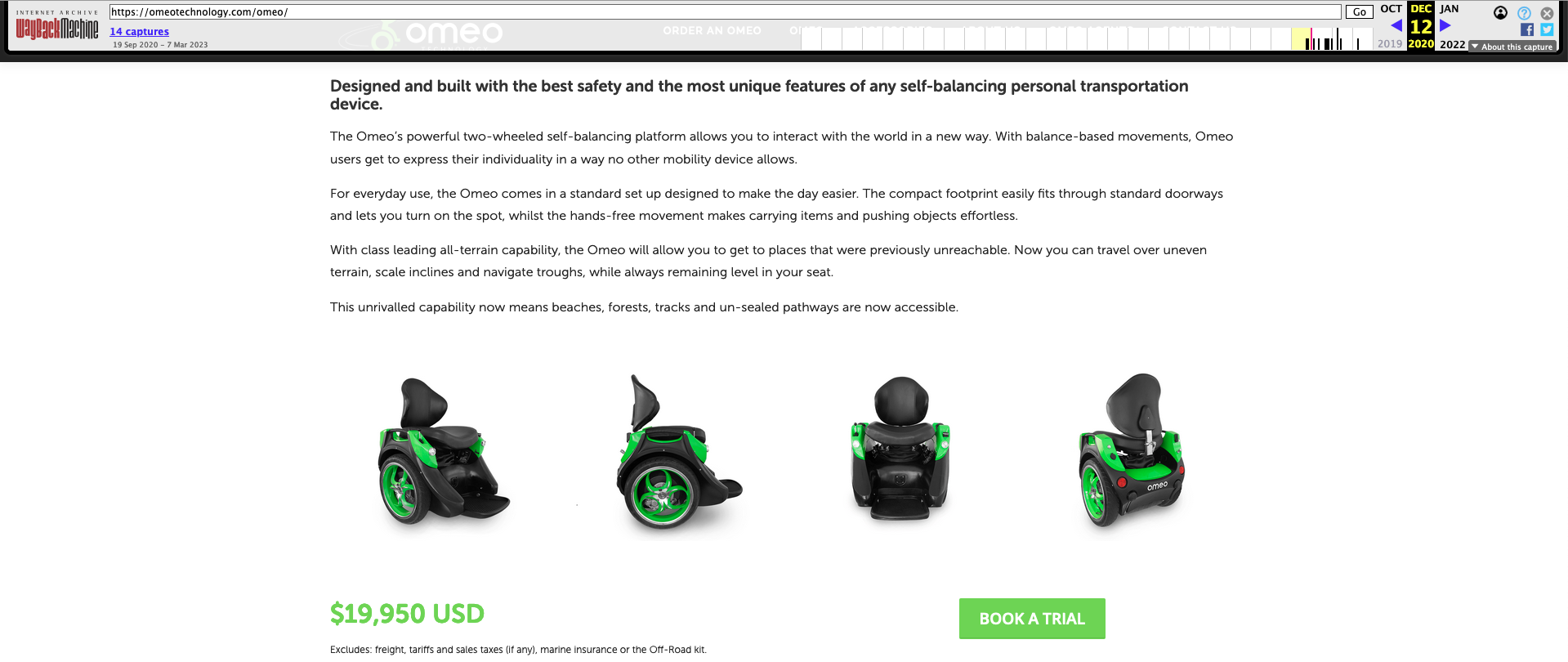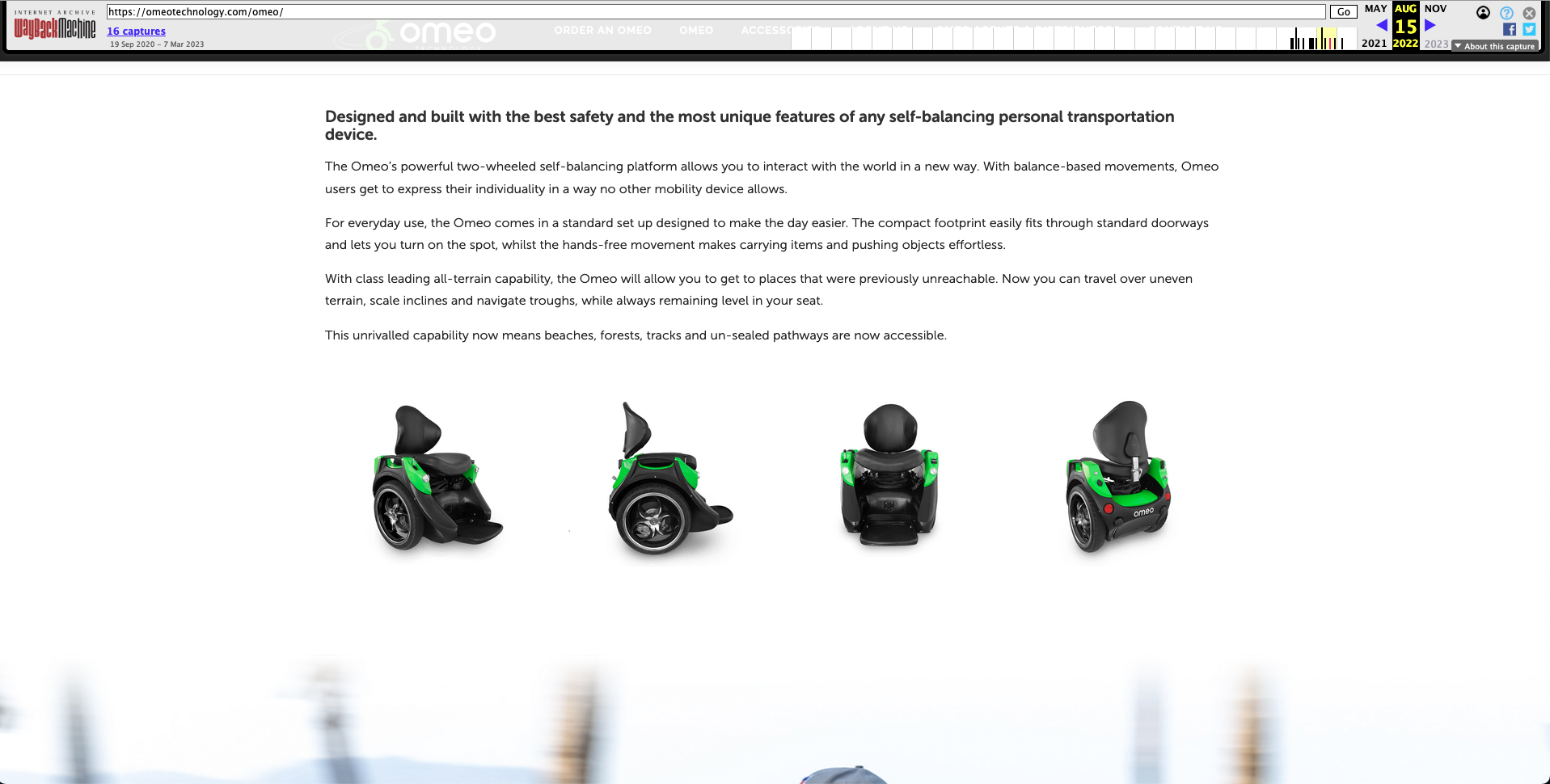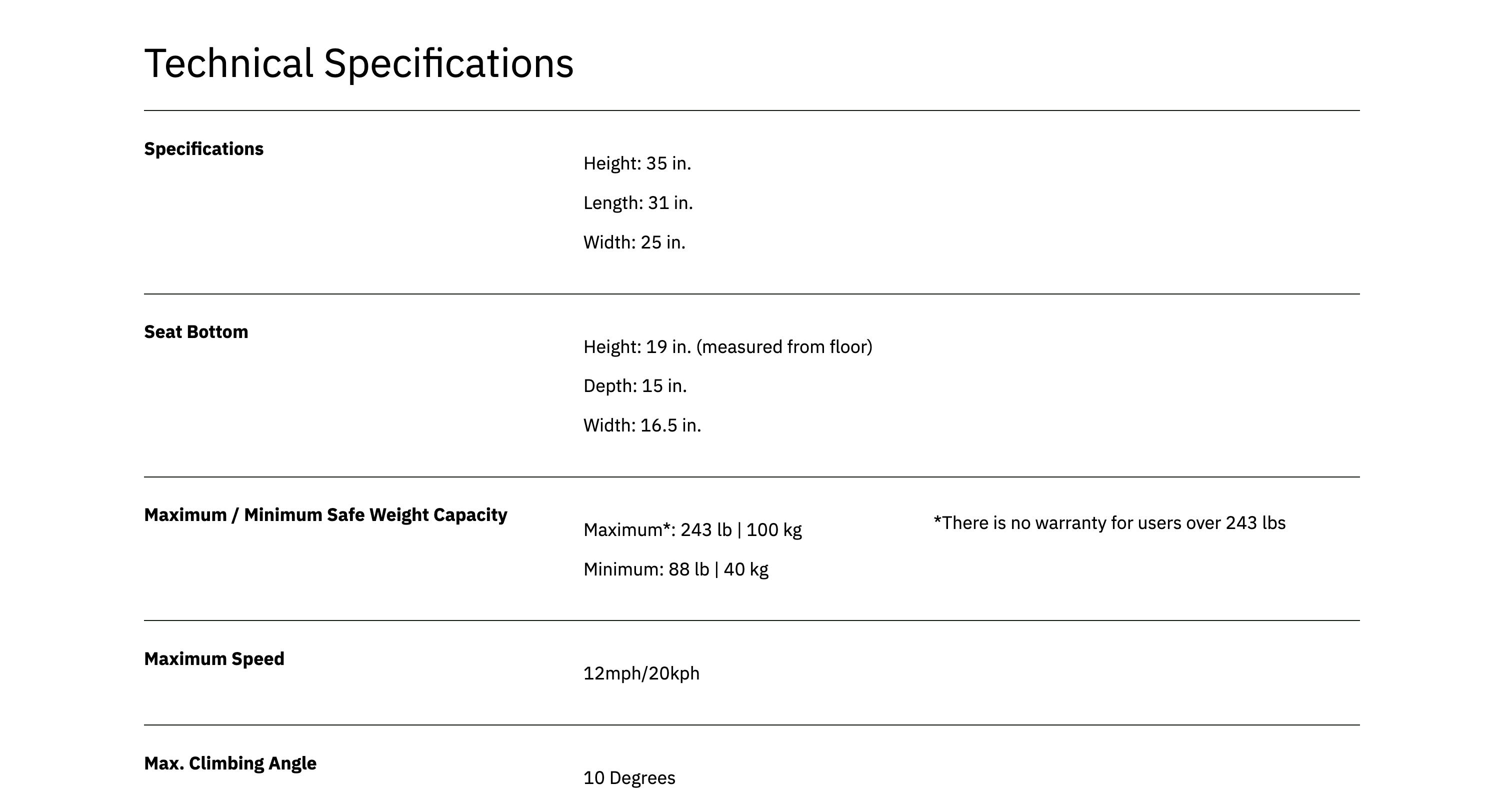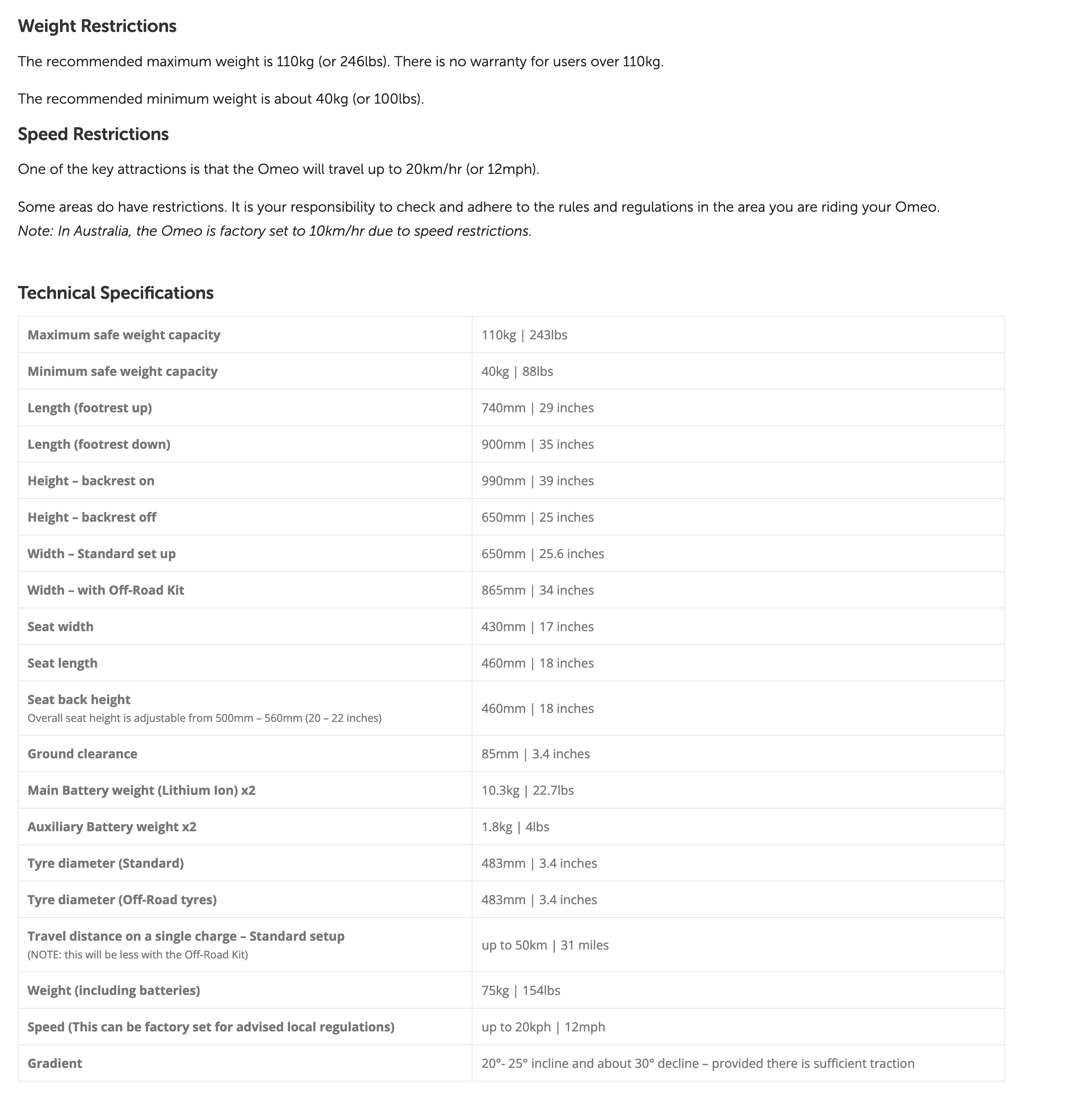The Omeo Wheelchair is Still a (Very Expensive) Toy
Back in 2018, I wrote an article reviewing the Omeo (née Ogo). A lot of time has passed since then so let’s take another look at the product and the company that makes it.
New Pricing
Back in December of 2020, the price of the Omeo was listed as $19,950 dollars USD:

By April 2021 the price increased to $22,500 USD:

By August of 2022, the pricing information had been completely removed:

In March 2022, the MyOmeo.com domain was registered and, as April 2023, the price is now listed as $29,950.00 USD:

The thing to keep in mind is that the prices listed on the Omeo Technology website don’t include taxes, tariffs, or shipping costs. The price listed on the website includes customization and shipping. This makes it difficult to do an apples-to-apples comparison of the price changes over time.
Updated Information About Funding
in 2019 the section titled Apart from cash, are there other ways to fund the purchase?, said:
quote:An Omeo is ideal for crowd‐funding friends, family, interest groups or public campaigns. There are a number of foundations and charities that will assist and service groups such as Rotary and Lions may also be able to help. We have heard of charities running competitions (for an Omeo). One of our Omeo agents has arranged an unsecured lending facility on very reasonable terms through a reputable funder. Your own local finance company or bank may be able to help too!
end quote

The link to Lightstream listed in the original article is no longer functional and there is no archive of it in the Wayback machine.
As of April 2023, that same section now states:
quote:An Omeo is ideal for crowd‐funding friends, family, interest groups or public campaigns. There are a number of foundations and charities that will assist and service groups such as Rotary and Lions may also be able to help. We have heard of charities running competitions (for an Omeo). It’s best to speak to your local Omeo Agent about the financing options available in your area.
end quote

The answer no longer mentions Lighstream.
A Brand New Website
In March 2022, Omeo Technology registered a new website, MyOmeo.com, and marketed it towards American consumers with a focus on user stories and product features.
For example, you’ll find a very little technical information on the American site:

Compared to the New Zealand Site:

In addition to more detailed specifications, the New Zealand site also has an instructional video as well as an extremely detailed user manual. The American site doesn’t appear to have either of these things, which I find really fucking weird. If I had to guess, they’re giving you as little information up front so that you’ll reach out to one of their agents. Omeo doesn’t make it clear whether or not their agents receive any kind of financial compensation or commission for their work.
The Same Old Problems
Despite a new domain, website, and marketing materials, the Omeo still suffers from the same limitations I mentioned in my 2018 article.
It Still Doesn’t Have Armrests
From the FAQ page (US):
quote:At this point in time the Omeo is designed to be armrest free. Because the Active Seat Control is designed to do all the work and safely and securely keeps users in, there are only hand grips built into the Omeo.
end quote
Five years later and they still won’t offer the most basic support.
It Still Has Terrible Ground Clearance
The website and user manual list the ground clearance as 85mm (3.3in), roughly the width of a credit card. The user manual states that the Omeo has “2 adjustments of 50mm (2in.) increments in height” to:
- Increase the ground clearance
- Allow for the Seat to Footplate height to be adjusted according to your leg length.
Assuming these two increments are in addition to the 3.3in base ground clearance, that gives you a total possible ground clearance of roughly 7 inches (177.8mm) or the length of a #2 pencil.
While 7 inches might sound reasonable, keep in mind that the height of the footrest is meant to be adjusted to to your leg length. So, giving yourself maximum clearance could mean putting your knees up closer to your chest, affecting your balance. And, unlike a manual wheelchair, you won’t be able to pop a wheelie to go over taller obstacles.
Additionally, I can’t even tell if you if those ground clearance measurements are accurate. According to the New Zealand FAQ, the ground clearance is roughly 2 inches (50mm):
quote:If the Omeo comes across an “ obstacle” that it is unable to handle say over 50 mm/2 inches. The machine would stay balanced but keep trying to go in the direction you are pointed. It would then give you warning vibrations to let you know you are pushing the machine to do something beyond what it is capable.
end quote
And the user manual states that an obstacle is anything over 1.5 inches:
quote:Avoid:
end quote
- Obstacles that the wheels cannot roll over with ease (greater than 40 mm/1.5 inches), for example, steps, curbs and potholes
- Surfaces where the body of the Omeo may get caught up due to contact
- Becoming airborne, as a change in orientation of your Omeo at speed could cause tripping.
Which means you’d struggle to get over a fucking golf tee.
The Off-road Kit (Still) Doesn’t Fit Through Doors
From the FAQ page (US):
quote:The Omeo fits between standard doorways that measure between 28 to 30 inches. When you have your standard tires on your Omeo the width will be 25.6 inches. If you purchased the off-road tires and have those on your Omeo will be wider and measure approximately 34 inches in width, thus you would need larger than standard doorways in your home to fit the off‐road tires.
end quote
For reference, an ADA compliant ramp is 36 inches (91.44cm) wide. With the off‐road tires on, this thing will barely fit on a standard wheelchair ramp.
It’s About The Width of An Airline Seat (And Nothing is Adjustable)
The technical specifications list the seat width at 17 inches and seat depth at 18 inches. Your average airline seat is 17 inches wide.
And these measurements are fixed. Seat back, ground clearance and the overall width of the device cannot be adjusted by either the user or the manufacturer. You get what you get.
It Still Can’t Handle Inclines
According to the specifications on the New Zealand site, the Omeo can handle "a 20°- 25° incline and about 30° decline - provided there is sufficient traction".
If you take a look at the steepest streets in Seattle, you’ll notice that several of them exceed this limit — and that’s just for what you can go up and down. If you want to go across an incline, you’re limited to roughly 20 degrees:
quote:Avoid:
end quote
- Sudden changes of direction at speed
- Riding across slopes greater than 20 degrees
- Riding into or onto changeable surfaces at speed where one wheel will rise above the other
- Dropping one wheel down a slope or hole.
Also, if you go down a hill while your battery is fully charged, it may cause the Omeo to shut down:
quote:It is important to note that if your batteries are fully charged at the top of a slope / hill, when you descend, you may feel your Omeo’s speed being limited to prevent from overcharging the Lithium‐ion Batteries. This could cause and (sic) Safety Shutdown.
end quote
It Requires a Fucking Helmet
No, seriously. From the user manual:
quote:WARNING
It is recommended that the rider always wears an approved bicycle or skateboard helmet while operating the Omeo in accordance with local laws, regulations, bylaws, standards and conventions. (All Omeo Technology media presented without the use of a helmet is conducted under controlled conditions by Omeo professionals and is not to be considered as standard practise.)
end quote
The promo videos for this fucking thing show a woman using a fucking stove while riding around inside. None of the users in the promotional videos (save for the training manual) show the user wearing a helmet.
In fact, the user manual recommends you wear a helmet no fewer than 5 times.
It (Still) Costs as Much as a Fucking Car
For the cost of an Omeo, you could drive a brand new 2023 Honda accord LX ($27,295.00) off the lot today and still have money left over.It (Still) Not a Wheelchair
Once again, from their fucking FAQ page:
quote:Unfortunately, Omeo is not FDA‐approved as a medical grade wheelchair, even though Omeo users use the Omeo as their primary personal mobility device in place of a wheelchair.
That means that few insurance companies choose to cover the Omeo.
end quote
In fact, I’ll go one step further and say that not only is the Omeo not a wheelchair, it is in fact (mostly) a Segway! From the user manual (emphasis mine):
quote:Use only Omeo & Segway approved parts and accessories. Do not modify the Omeo. Modifications to the Omeo that are not performed by Omeo Technology or Certified Omeo Service Technicians, could interfere with the operation of the Omeo. This has the potential to result in serious injury and/ or damage and could void the Omeo Worldwide Limited Warranty and Segway Limited Warranty.
end quote
In total Segway is mentioned 112 times and the Segway PT User Manual is mentioned 63 times. This thing is a goddamn Segway and it’s going to do nothing but make life harder for people in actual powered wheelchairs. If you thought that someone claiming their yappy purse-chihuahua is an emotional support animal in the middle of a Starbucks was bad, wait until somebody in an Omeo crashes into a display case at 12 miles per hour or starts screaming at a manager because they won’t turn off the security scanners to keep from damaging their $30,000 not‐a‐wheelchair (more on that later).
But Wait, There’s More!
Here’s a list of fun facts I just didn’t have time to cover:
- The manual contains 78 separate warnings.
- Carrying anything in your lap will interfere with the Omeo’s ability to balance and may result in serious injury (see: page 63 of the user manual).
- The Omeo takes a full 10 seconds to stop and shut down if you fall out of it (see: page 40 of the user manual). Remember this thing ways over 100lbs and can go 12mph.
- The Omeo is not intended for use at elevations greater than 2,000 metres (6,500ft) above sea level (see: page 41 of the user manual).
- If you go near a security scanner in a building (like every grocery store or concert venue), it could fuck up your 30K dollar toy (see: page 97 and page 5 of the user manual)! They seriously want you to ask the building manager to disable the security scanners so you can safely operate your doo‐dad indoors!
- Whenever the Omeo is not in use, it has to be plugged in to AC power to avoid damaging the batteries (see: page 67 of the user manual).
- The manual wants you to "[e]nsure you have alternative mobility solutions available" in the event of a problem or power failure (see: page 70 of the user manual).
- If you use “low quality or cheap” (their words) batteries in your Omeo’s remote, you risk damaging it and not being able to power on the Omeo (see: page 86 of the user manual).
- The Omeo comes with 4 tie down points (“a requirement on some public transport”) for transport, but is not “designed for a user to remain seated as a passenger or driver in a vehicle” (see: page 79 of the user manual). In other words, if you somehow take this thing on a bus, you’d need to tie it down and then transfer out of it to a normal seat.
- For transport in a car, they recommend you secure the Omeo “using the tie down points and/or Handgrips” (see: page 77 of the user manual) while simultaneously telling you avoid using the handgrips as tie down points (see page: 79 of the user manual).
That’s not even an exhaustive list. I highly encourage you to read through the user manual so you have a full understanding of the limitations of the device.
